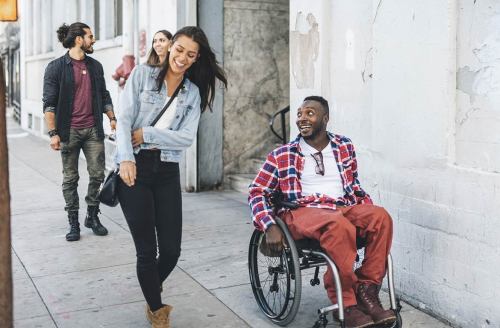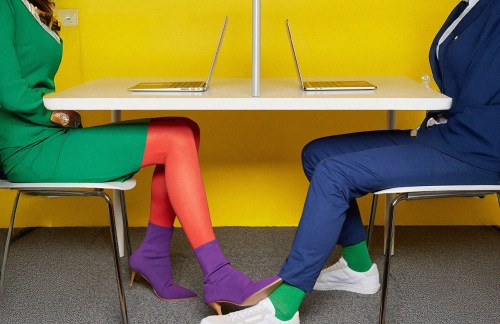July is Disability Pride Month. If you didn’t know about it, that’s part of why it needs to be celebrated. While millions of people live with disabilities and anyone can become disabled at any time, any attention too often takes the form of pity. Disability Pride Month celebrates disabled people with a reminder that being disabled isn’t a bad thing.
While Disability Pride Month isn’t a national celebration, New York City has recognized it as an opportunity to “amplify one another” since 2015. Disability Pride Day parades are also held in cities throughout country, including Los Angeles, San Antonio, and Madison, Wisconsin, among others.
“This annual observance is used to promote visibility and mainstream awareness of the positive pride felt by people with disabilities,” says disability rights organization AmeriDisability. “Pride comes from celebrating our heritage, disability culture, the unique experiences that we have as people with differing abilities, and the contributions that we offer society.”
Disability allyship means supporting the disabled community in more ways than one. Below, five people with disabilities share how to become a better ally.
How to be a better ally to people with disabilities
1. Disability isn’t a dirty word
Many euphemisms for disabled have cropped up over the years like “special needs” and “differently abled.” Disability rights advocates say that these words make it seem as if being disabled is a bad thing. While there are certainly offensive terms that refer to people with disabilities, “disabled” isn’t one of them.
Hannah Griffin, who self-identifies as a professional patient, shared in an Instagram post that people shouldn’t be afraid to say “disabled.” “Being disabled isn’t wrong or gross and it isn’t a dirty word,” says Griffin. “Disability is more than just the physical and/or mental effects on the body. Disability is more than the pills that you take or the doctors that you see. It’s a part of who you are.”
2. Understand basic wheelchair etiquette
Editor and fanfiction writer Charlie Knight shared in a Twitter thread some basics everyone should know about wheelchair etiquette. For starters, it is never okay to move someone’s wheelchair (whether they’re in it or not) without their permission. “A wheelchair is an extension of our bodies,” says Knight. “If you wouldn’t lift and move an abled person without asking, don’t push a wheelchair.” Unless you’d be screaming to be heard, they say there’s no need to bend down to speak to someone in a wheelchair. Plus, you should go out of your way to avoid saying things like “take a walk.” “We’re pretty likely to express things that way too, and ‘take a roll’ as a cutesy alternative is not as funny as you think,” they said.
Since it’s Disability Pride Month, I’d love to address something I see many issues with out in the wild:
3. Remember that there is no one way a disabled person can look
While some disabilities are obvious to the eye, many aren’t. Keep in mind that you never know when you’re interacting with a person who is disabled.
“One of the most common comments that I get on my videos is ‘why should we care about access and ableism when disability only affects a small portion of the population?’ But this simply isn’t true—one in four people are disabled,” shares disability rights activist Isabel Mavrides-Calderón in a TikTok. “Which means you almost definitely know someone who is disabled or will one day become disabled. Rember, 90 percent of disabilities are invisible. It could be your co-worker, your neighbor, your friend, and one day even you.”
4. Don’t lead with assumptions
Instead of letting your assumptions guide your thoughts, do your research, and if you know a disabled person who wants to share things about their disability, give them the space to share.
“Knowledge is power, and giving someone the opportunity to explain their condition helps everyone involved feel more comfortable, understood, and accommodated for,” says Well+Good senior food editor Betty Gold. “Once I say I have diabetes, I appreciate it [if people] allow me to explain what type 1 is without assuming a lot of things. People always say, ‘Wow, so you can’t eat any sugar then?’ or say something really rude about how they could never have diabetes because they hate needles.”
5. Offer help, just like you would offer it to anyone else
You don’t want to infantilize people with disabilites, but offering to help is often welcomed. It’s just like offering help to anyone else. For example, Spencer West, a disability rights activist who uses a wheelchair explained in a TikTok video that rainy days are difficult for him. “When it rains going outsides sucks. The reason is, my wheelchair gets soaked and it takes 12 hours to dry,” he says in the video. “If you have disabled folx in your life, check-in. See if they need some help or if you can offer some support.”
Oh hi! You look like someone who loves free workouts, discounts for cult-fave wellness brands, and exclusive Well+Good content. Sign up for Well+, our online community of wellness insiders, and unlock your rewards instantly.
Sign Up for Our Daily Newsletter
Get all the latest in wellness, trends, food, fitness, beauty, and more delivered right to your inbox.
Got it, you've been added to our email list.











